For prime aerial travel photos, you'll want to target specific times of day. Golden hour, occurring just after sunrise and before sunset, bathes landscapes in warm, golden light. Blue hour, happening shortly before sunrise or after sunset, offers a deep blue sky contrasting with city lights. Sunset itself provides dramatic colors and long shadows. Even midday can yield striking results, with harsh light creating sharp shadows and accentuating textures. Don't forget about night photography, which can capture stunning starry skies. Each of these times offers unique opportunities to capture breathtaking aerial shots. Explore further to master the techniques for each magical moment.
Golden Hour Magic
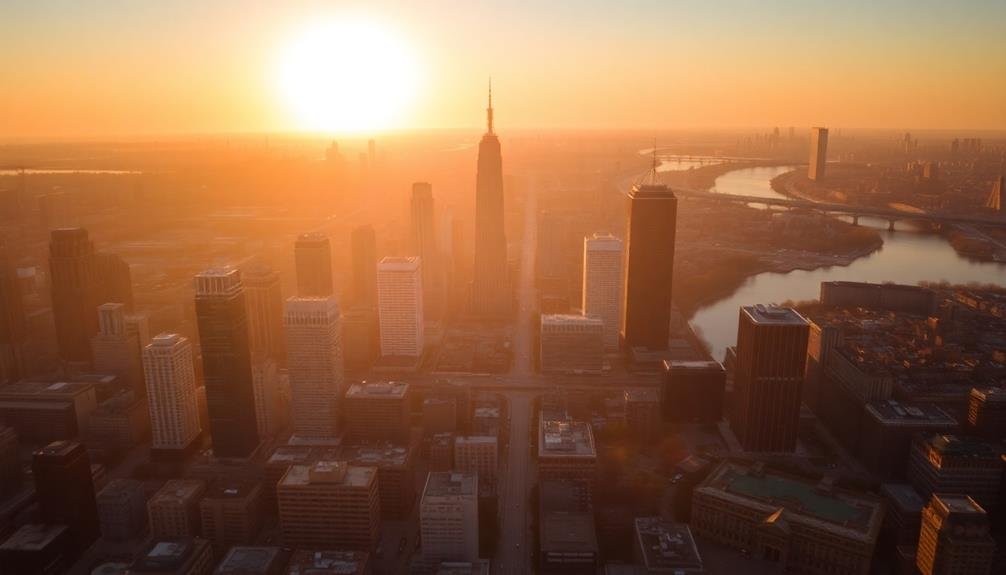
As the sun dips down toward the horizon, the golden hour casts its magical spell over the landscape. You'll find this enchanting period occurring twice daily: just after sunrise and before sunset. During these fleeting moments, the light takes on a warm, golden hue that bathes everything in a soft, ethereal glow.
From above, you'll witness long shadows stretching across the terrain, creating depth and texture that's often lost in harsh midday light. Cities come alive with a warm radiance, their buildings and streets transformed into a glittering tapestry. Rural areas reveal hidden contours and patterns as fields and forests are painted in rich, warm tones.
To capture this magic, you'll need to plan ahead. Research sunrise and sunset times for your location and arrive early to set up. Use apps or websites to pinpoint the sun's position and trajectory.
Experiment with different altitudes to find the perfect balance of light and shadow. Don't forget to adjust your camera settings to compensate for the changing light conditions. Remember, the golden hour is brief, so be prepared to work quickly and efficiently to make the most of this photographic opportunity.
Blue Hour Brilliance
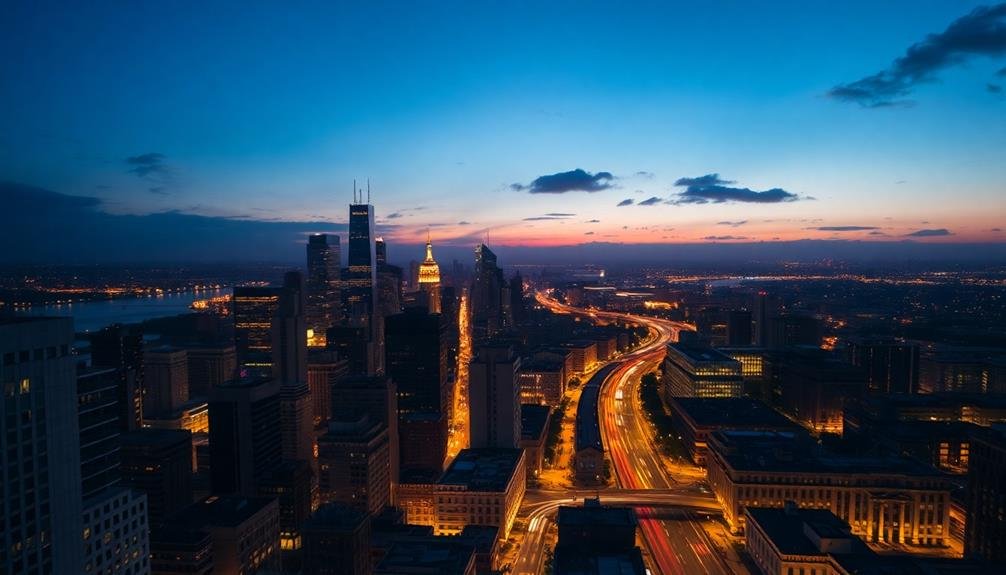
Shifting from golden to blue, the magical blue hour offers a unique opportunity for photographers to capture stunning twilight scenes. You'll find this ethereal time just before sunrise or after sunset when the sky takes on a deep blue hue. It's a brief window, lasting only 20-30 minutes, but it's worth the effort to capture its unique beauty.
During blue hour, you'll notice a perfect balance between natural and artificial light. Cityscapes come alive as street lamps and building lights contrast beautifully against the darkening sky. To make the most of this fleeting moment, you'll want to:
| Technique | Equipment | Subject |
|---|---|---|
| Use a tripod | Wide-angle lens | Cityscapes |
| Shoot in RAW | ND filters | Seascapes |
| Bracket exposures | Remote shutter | Architecture |
| Set low ISO | Flashlight | Monuments |
| Use manual mode | Extra batteries | Reflections |
Remember to arrive early to scout your location and set up your equipment. You'll need to work quickly as the light changes rapidly. Experiment with long exposures to capture light trails and smooth water surfaces. Don't forget to adjust your white balance to maintain the blue tones accurately.
Midday Shadows and Textures
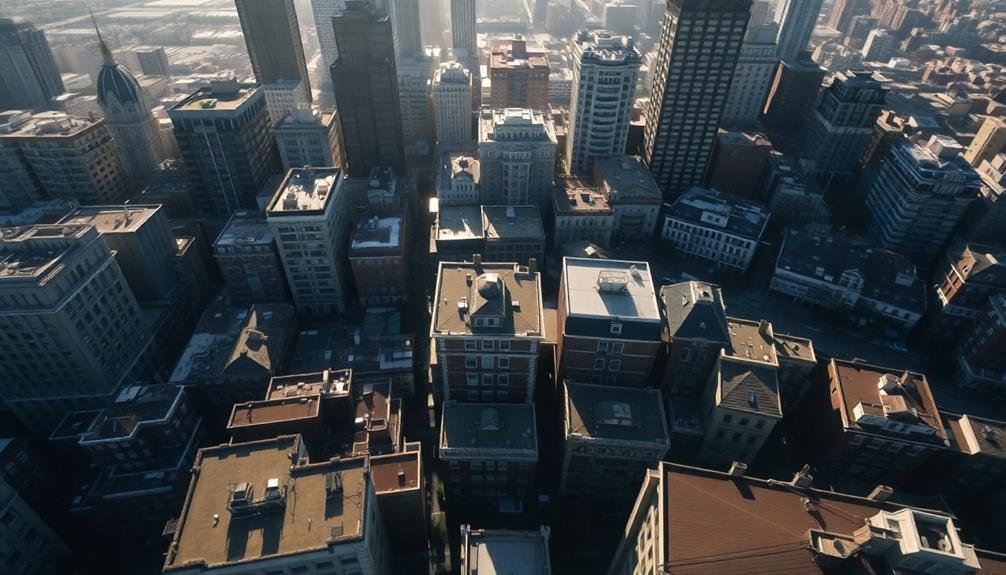
Harsh midday light often intimidates photographers, but it's a prime opportunity to capture striking shadows and textures. From above, you'll find that the sun's zenith position creates sharp, well-defined shadows that can add depth and contrast to your images. Look for interesting patterns formed by buildings, trees, or landscapes as they cast their shadows across the ground.
Focus on architectural details that become more pronounced under direct sunlight. Rooftops, facades, and urban grids reveal intricate textures and geometries that might be lost in softer light.
In natural settings, observe how the intense light accentuates the texture of forests, fields, or desert landscapes.
Use the strong contrast to your advantage by experimenting with black and white photography. The stark differences between light and shadow areas can create dramatic, high-contrast images that emphasize form and structure.
When shooting from above during midday, consider using a polarizing filter to reduce glare and enhance colors, especially when capturing water bodies or reflective surfaces.
Adjust your camera settings to prevent overexposure, opting for a faster shutter speed or lower ISO to maintain detail in bright areas.
Sunset Spectacles

The golden hour of sunset offers photographers a prime opportunity to capture stunning aerial shots. As the sun dips towards the horizon, you'll witness a transformation of the landscape below. Long shadows stretch across the terrain, creating depth and drama in your images. The warm, golden light bathes everything in a soft glow, enhancing colors and textures.
To make the most of sunset spectacles, you'll want to be in position well before the sun touches the horizon. Scout your location in advance, considering both foreground elements and the backdrop. Here's a quick guide to sunset aerial photography:
| Time | Light Quality | Subject Focus |
|---|---|---|
| Pre-sunset | Warm, soft | Landscape details |
| Golden hour | Golden, intense | Silhouettes, colors |
| Blue hour | Cool, dim | City lights, mood |
| After sunset | Fading light | Long exposures |
As you shoot, experiment with different angles and compositions. Capture the sun's reflection on water bodies, highlight architectural features bathed in golden light, or frame natural landscapes with dramatic cloud formations. Don't forget to adjust your camera settings to account for the rapidly changing light conditions.
Night Sky Wonders
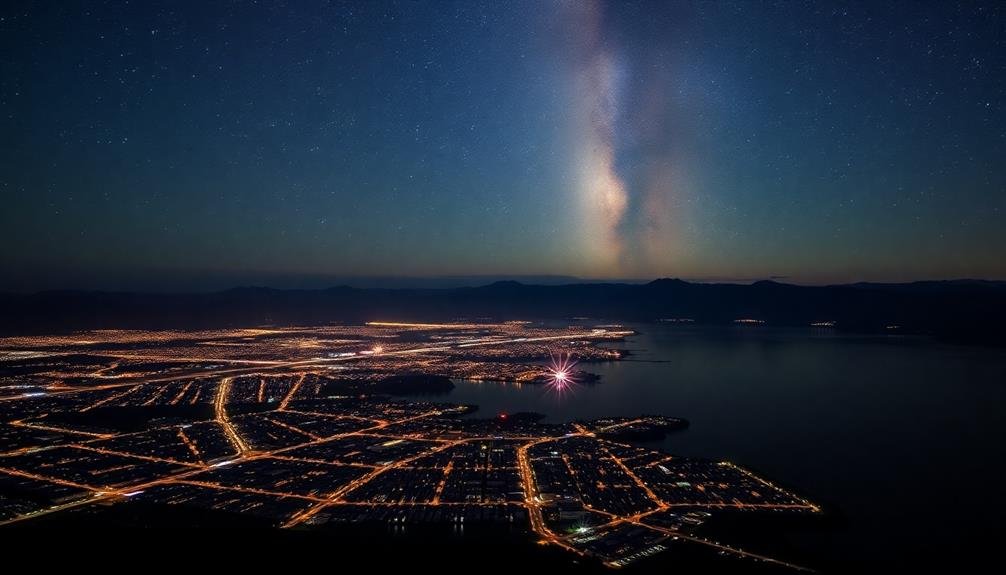
Darkness blankets the landscape, revealing a mesmerizing celestial display perfect for night sky photography. You'll find the best conditions for capturing these cosmic wonders between 2-4 hours after sunset and 2-4 hours before sunrise. During these periods, the sky is at its darkest, allowing stars, galaxies, and other celestial objects to shine brightly.
To capture stunning night sky photos, you'll need a camera with manual settings, a wide-angle lens, and a sturdy tripod. Set your camera to a high ISO (1600-3200), use a wide aperture (f/2.8-f/4), and experiment with long exposures (15-30 seconds). Don't forget to focus manually on a bright star or distant light source.
Look for interesting foreground elements to add depth to your compositions. Mountains, trees, or architectural features can create striking silhouettes against the starry backdrop.
If you're lucky, you might capture the Milky Way, meteor showers, or even the Northern Lights. Remember to check the moon phase and weather conditions before planning your shoot, as a full moon or cloudy skies can hinder your efforts to photograph the night sky's wonders.
Frequently Asked Questions
What Camera Settings Are Best for Aerial Photography at Different Times?
You'll want to use a fast shutter speed (1/1000s or higher) and a mid-range aperture (f/8-f/11) for aerial shots. Adjust ISO based on light conditions. Use continuous autofocus and burst mode for sharp images.
How Does Weather Affect the Ideal Timing for Aerial Shots?
Weather greatly impacts your aerial shot timing. You'll want clear skies for vibrant colors and sharp details. Avoid overcast days, but light clouds can add interest. Golden hour lighting enhances landscapes, while midday sun's harsh for most scenes.
Are There Legal Restrictions on Drone Photography During Certain Hours?
You'll face legal restrictions on drone photography during certain hours. Many countries prohibit night flights and limit operations near sunrise and sunset. Check local regulations, as they often restrict flying times to guarantee safety and privacy.
What Safety Precautions Should Be Taken When Photographing From Aircraft?
When photographing from aircraft, you'll want to secure your gear, avoid blocking others, and listen to crew instructions. Don't use flash or stick cameras out windows. Stay seated during takeoff and landing. Always prioritize safety over getting the shot.
How Can Photographers Plan for Optimal Lighting Conditions in Unfamiliar Locations?
You should research sunrise and sunset times, check weather forecasts, and use apps like PhotoPills to plan golden hour shots. Scout locations in advance, if possible. Don't forget to take into account local geography and seasonal light variations.
In Summary
You've explored the best times for aerial photography, from golden hour's warm glow to blue hour's ethereal light. You've seen how midday sun creates stark shadows and textures, while sunsets paint the sky in vibrant hues. You've even discovered the allure of nighttime shots. Remember, each time offers unique opportunities. So grab your camera, take to the skies, and capture stunning images that showcase the world from above.

As educators and advocates for responsible drone use, we’re committed to sharing our knowledge and expertise with aspiring aerial photographers.
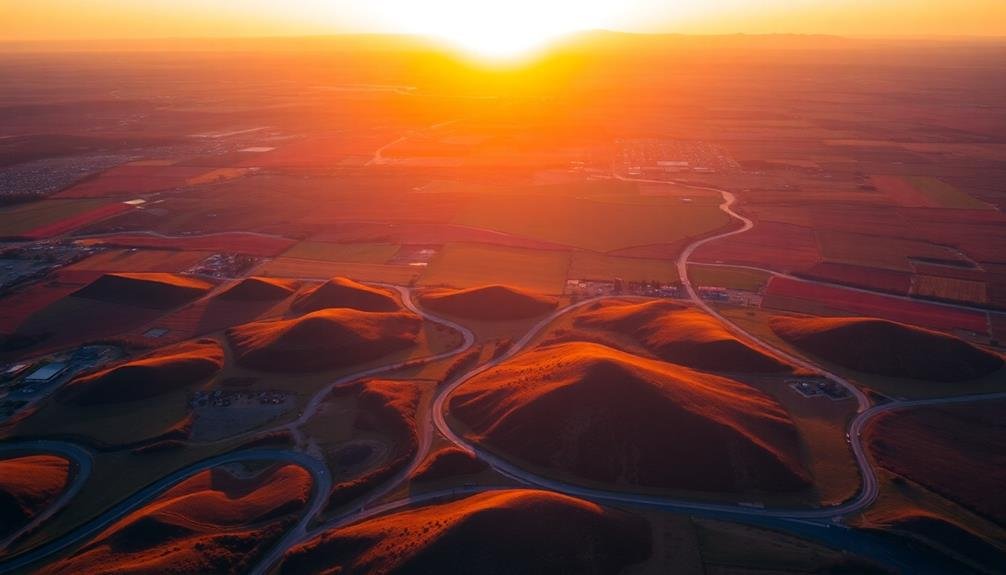



Leave a Reply